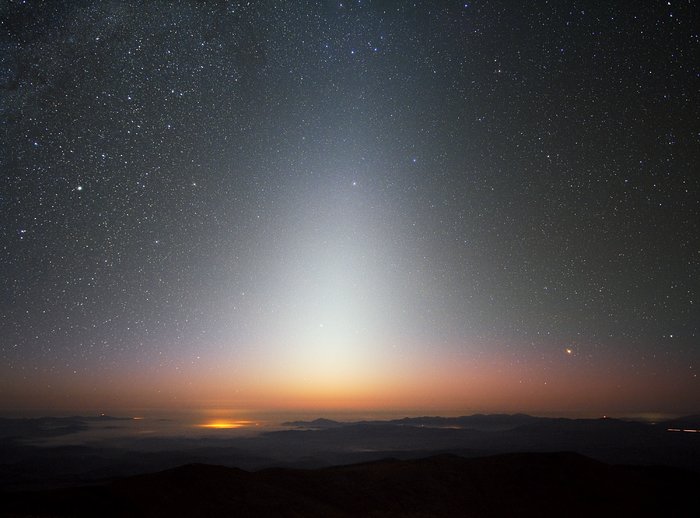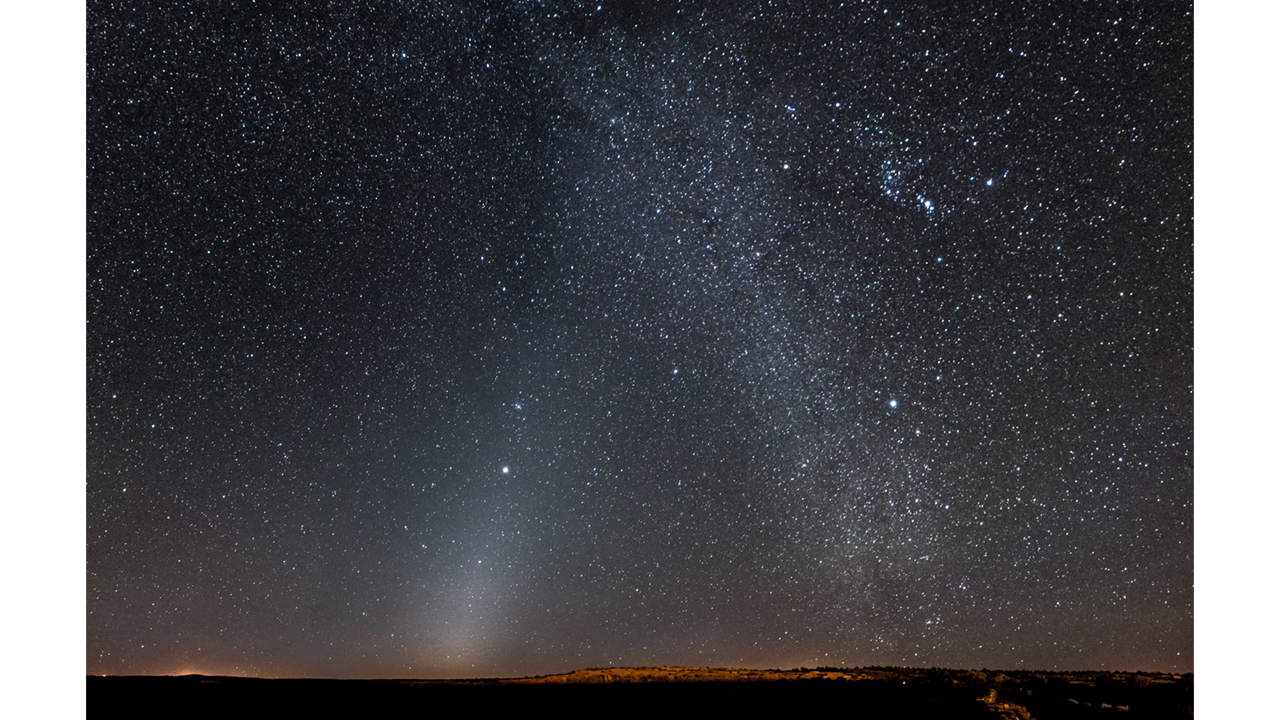Stardust and Eternity – 3.2.2
The Zodiacal Light
The “zodiacal light” is a typical glowing band of light visible in the night sky about an hour after sunset or before dawn. It appears as a tilted, faint, hazy cone of light that tapers above the position of sunset or sunrise on the horizon. It is referred to as a “false dawn” when observed in the East – before sunrise – or “false dusk” when seen in the West – just after sunset. The zodiacal light is comparable in brightness to the Milky Way: it can be easily mistaken for it, due to its whitish appearance, its angular width, and its extension along the ecliptic line – the apparent path of the Sun in the sky along Earth’s orbit plane. Like the Milky Way, however, the zodiacal light is very faint and is easily obscured by light pollution or moonlight.
As for its physical origin, zodiacal light is a product of the scattering of sunlight by interplanetary dust that pervades the space between planets in the Solar System plane. This is basically the same process we normally witness when the sunrays come through a window; we can observe their reflection coming from the dust that floats freely in the air. When analysed with spectrographs, its electromagnetic spectrum is therefore the same as the Sun’s. However, the interplanetary dust particles that compose the zodiacal dust are extremely sparse, with an average size of just one millionth of a metre – the size of smoke particles. A cubic kilometre of space contains only a few dust particles, and altogether their mass is equivalent to that of an asteroid about 30 km in size. Most of the grains that form zodiacal dust are remnants of the process that created the planets of our solar system, although they are continually being replenished by cometary debris, material pulverised by asteroid collisions, and even Mars’ dust storms.
As for its visibility, zodiacal light is best seen around the equinoxes, i.e. the two times of the year (21st March and 23rd September) when the Earth’s axis is neither tilted towards nor away from the Sun – so that day and night are of approximately equal length. During equinoxes, the inclination of the ecliptic – which changes throughut the year – becomes almost vertical and is therefore more favourable for the observation of this faint band of light. Finally, there is also a brighter zone directly opposite the Sun, known as “counterglow”; however, it is even more elusive than normal zodiacal light and to observe it – or to know where too look – a proper dark-sky location is requires.


Further Resources
Links below will redirect you to external websites. In accordance with the European data protection declarations, we would like to point out that by clicking on these links you may send data to external providers. We cannot prevent that.
Images
![]() Zodiacal light over La Silla (ESO/Y. Beletsky)
Zodiacal light over La Silla (ESO/Y. Beletsky)
![]() Zodiacal light and the Milky Way (HST/Zolt Levay Photography)
Zodiacal light and the Milky Way (HST/Zolt Levay Photography)
![]() Zodiacal Light and the False Dawn (Yuri Beletsky, ESO)
Zodiacal Light and the False Dawn (Yuri Beletsky, ESO)
Videos
![]() Zodiacal light: Cosmic Dust Reflection
Zodiacal light: Cosmic Dust Reflection

 Le sabbie di Marte all’origine della Luce Zodiacale (MEDIAINAF TV)
Le sabbie di Marte all’origine della Luce Zodiacale (MEDIAINAF TV)
Online Resources
![]() Zodiacal Light: The Definitive Photography Guide
Zodiacal Light: The Definitive Photography Guide
 La ‘luce zodiacale’: un affascinante fenomeno (PassioneAstronomia)
La ‘luce zodiacale’: un affascinante fenomeno (PassioneAstronomia)
 Luce zodiacale, ecco come osservarla (Focus)
Luce zodiacale, ecco come osservarla (Focus)
Further Readings
![]() The Stargazer’s Guide to the Night Sky (Jason Lisle)
The Stargazer’s Guide to the Night Sky (Jason Lisle)
 La Luce Zodiacale (A. Serpieri)
La Luce Zodiacale (A. Serpieri)
Teaching Material
For Kids
